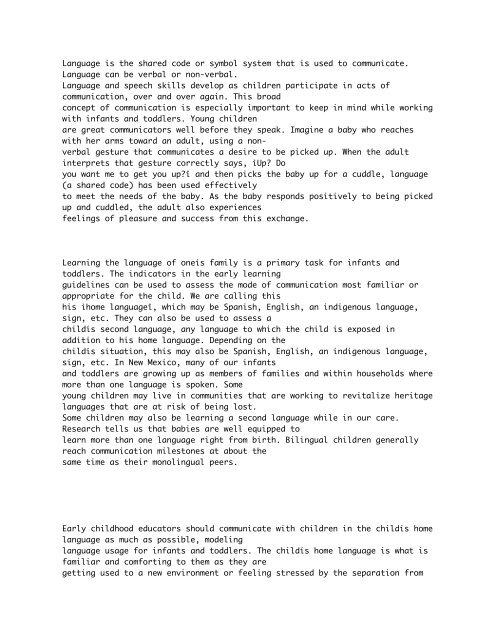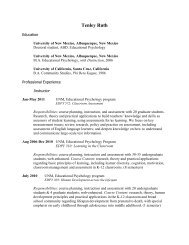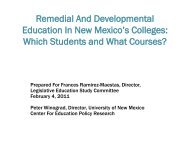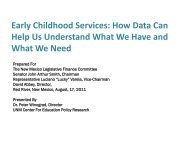- Page 5 and 6:
WHAT ARE EARLY LEARNING GUIDELINES?
- Page 7:
student achievement.Photo 3.PNGPhot
- Page 10 and 11:
ï To help understand the complexit
- Page 12:
irth through kindergarten age. In c
- Page 17 and 18:
The New Mexico Early Learning Guide
- Page 19 and 20:
sensory and brain development. Ever
- Page 21 and 22:
communication andinteractions with
- Page 23 and 24:
children are not just products of t
- Page 25:
The Chief Council of State School O
- Page 28 and 29:
Domain I: Beginning to Know About O
- Page 30 and 31:
CreativityPersistenceProblem Solvin
- Page 32 and 33:
development: how very young childre
- Page 34 and 35:
ï "In what ways does this baby dem
- Page 36 and 37: Charts for each domain will contain
- Page 38 and 39: Summary of Indicators for Young Inf
- Page 40 and 41: Begin to listen to words with under
- Page 42 and 43: Gain control of head andbodyMove bo
- Page 44 and 45: Express own needsFollow simple rout
- Page 46 and 47: Participate in socially expectedcon
- Page 48 and 49: Begin to controlmovements using arm
- Page 50 and 51: Demonstrate different emotions ormo
- Page 52 and 53: Use sounds and words in social situ
- Page 54 and 55: Begin to use simple toolsShow incre
- Page 56 and 57: Demonstrate an increasing ability t
- Page 58 and 59: Initiate socially expected communic
- Page 60 and 61: independentlyCoordinate several sen
- Page 62 and 63: Domain: Beginning to Know About Our
- Page 64 and 65: awareness of his own abilities by f
- Page 66 and 67: Beginning to Know About Ourselves a
- Page 68 and 69: Express own needsGesture when hungr
- Page 70 and 71: Use self talk: Say ìnoî when reac
- Page 72 and 73: Respond to emotional cues: smilebac
- Page 74 and 75: Tell mom, ìDonít sing!îGive orde
- Page 76 and 77: Participate in interactionsDisplay
- Page 78 and 79: unfamiliar adultsHold adultís hand
- Page 80 and 81: Demonstrate attention by watchingBe
- Page 82 and 83: interaction skills with peersPartic
- Page 84 and 85: Domain: Beginning to CommunicateDom
- Page 88 and 89: use of language by a caregiver. So
- Page 90 and 91: Respond non-verbally to gesturesand
- Page 92 and 93: word when asked "Who?" or "Where?"q
- Page 94 and 95: lips) or bubbles to experiment with
- Page 96 and 97: Use adjectives in phrases ñ ìbig
- Page 98 and 99: Pick up small toy with thumb andfin
- Page 100 and 101: Explore writing as a means ofcommun
- Page 103 and 104: Domain: Beginning to Build Concepts
- Page 105 and 106: out of their written descriptions.
- Page 107 and 108: Explore size and shapePlay with toy
- Page 109 and 110: Begin to organize materials andinfo
- Page 111 and 112: Continue to bat at crib toy to make
- Page 113 and 114: Demonstrate beginning number andmea
- Page 115 and 116: Respond to music or chantingQuiet w
- Page 117: Try out new ways to get dressedDemo
- Page 120 and 121: (Both Brian and Sofia are showing t
- Page 122 and 123: Program planning works best when ea
- Page 124 and 125: Demonstrate increasing largemotor c
- Page 126 and 127: Follow toys with eyesReach for or s
- Page 128 and 129: Show increasing eye-handcoordinatio
- Page 130 and 131: Coordinate sucking, swallowingand b
- Page 132 and 133: Remove hat and mittensZip or unzip
- Page 134 and 135: Domain: Approaches to LearningDomai
- Page 136 and 137:
ï and Problem Solving ñ looks at
- Page 138 and 139:
Begin to demonstrate initiativeEnga
- Page 140 and 141:
Engage with objects that light up o
- Page 142 and 143:
Remember: You are likely to see the
- Page 144:
Aesthetic Creativity
- Page 147 and 148:
New Mexico PreK and Title Iì619î
- Page 149 and 150:
2.3 Holds writing tool in pincer gr
- Page 151 and 152:
5.1 Listens with understanding to d
- Page 153 and 154:
7.4 Progresses in understanding and
- Page 155 and 156:
#10 The child demonstratesunderstan
- Page 157 and 158:
DomainOutcomeIndicatorAestheticCrea
- Page 159 and 160:
#15 The child acquires scientific k
- Page 161 and 162:
#18 The child demonstrates self-con
- Page 163 and 164:
21.2 Accepts guidance and direction
- Page 165 and 166:
#24 The child takes initiative.24.1
- Page 167:
#28 The child uses problem-solving
- Page 171 and 172:
glue, Dominic?î William asks. ìSu
- Page 173 and 174:
coordinate their hands to pour juic
- Page 175 and 176:
MakingProgressAccomplishedfor 4ís(
- Page 177 and 178:
Uses smallerbeads, pegs andmanipula
- Page 179 and 180:
Domain: LiteracyDomain Vignette:In
- Page 181 and 182:
Domain Description:Literacy encompa
- Page 183 and 184:
Families transmit values, beliefs a
- Page 185 and 186:
Accomplishedfor K(End of K)Responds
- Page 187 and 188:
Followsincreasinglycomplexdirection
- Page 189 and 190:
Accomplishedfor 4ís(First Stepsfor
- Page 191 and 192:
letter-soundassociationswith beginn
- Page 193 and 194:
(First Stepsfor 4ís)MakingProgress
- Page 195 and 196:
connectedsentences toexpress ideasa
- Page 197 and 198:
for 4ís)MakingProgressAccomplished
- Page 199 and 200:
Listens to anadult read abook or ch
- Page 201 and 202:
Domain: LiteracyOutcome #7: The chi
- Page 203 and 204:
Uses ownexperiences tomakecomments
- Page 205 and 206:
Essential IndicatorsDomain: Literac
- Page 207 and 208:
(End of K)Identifies printin theenv
- Page 209 and 210:
Essential IndicatorsDomain: Literac
- Page 211 and 212:
Accomplishedfor K(End of K)Makes ma
- Page 213 and 214:
Writes somesimple wordsusing standa
- Page 215 and 216:
Children to a Higher Level, pp. 149
- Page 217 and 218:
Photo 19 NumeracyWhen You Are Obser
- Page 219 and 220:
correctlyassigns anumber to eachite
- Page 221 and 222:
110Essential IndicatorsDomain:Numer
- Page 223 and 224:
Domain Description:The arts provide
- Page 225 and 226:
First StepsMakingProgressAccomplish
- Page 227 and 228:
Communicatestwo ideas orfeelingsthr
- Page 229 and 230:
Domain: Scientific Conceptual Under
- Page 231 and 232:
Watch & Listen Ask & Wonder Reflect
- Page 233 and 234:
MakingProgressAccomplished for 3ís
- Page 235 and 236:
than verballyUses onesense (such as
- Page 237 and 238:
numbers orsymbols ongraphs andchart
- Page 239 and 240:
Accomplishedfor K(End of K)Asks ìw
- Page 241 and 242:
Developsalternativehypothesisbased
- Page 243 and 244:
they were going to have a birthdayp
- Page 245 and 246:
Keep in MindConsideration of each c
- Page 247 and 248:
4ísMakingProgressAccomplishedfor K
- Page 249 and 250:
and explainstheirimportance(beyondc
- Page 251 and 252:
Accomplishedfor 4ís(First Stepsfor
- Page 253 and 254:
and someadult helpPlacespersonal it
- Page 255 and 256:
ProgressAccomplishedfor 3ís(First
- Page 257 and 258:
Interacts withother children,sharin
- Page 259 and 260:
First StepsMakingProgressAccomplish
- Page 261 and 262:
and assistanceWith teacherguidanceg
- Page 263 and 264:
Domain Vignettes:Three four-year-ol
- Page 265 and 266:
Photo 23 Approaches.PNGWhen You Are
- Page 267 and 268:
3-Year-Old Rubrics4-Year-Old Rubric
- Page 269 and 270:
often choosingfavorite,familiaracti
- Page 271 and 272:
Indicator 24.2 (Essential Indicator
- Page 273 and 274:
Needsextensiveadult helpduringactiv
- Page 275 and 276:
Outcome #25: The child exhibits ima
- Page 277 and 278:
Adds dress-upclothes orother items
- Page 279 and 280:
ole playacross morethan one dayEsse
- Page 281 and 282:
Accomplishedfor K(End of K)Shows in
- Page 284 and 285:
Domain: Physical Development, Healt
- Page 286 and 287:
Photo 24 Gross Motor.pngWhen You Ar
- Page 288 and 289:
Indicator1.1(Essential Indicator #2
- Page 290 and 291:
esponse tothrowing,catching andkick
- Page 293 and 294:
Building PortfoliosWhen authentical
- Page 295 and 296:
what children do and say so thatthe
- Page 297:
Observerís Name DateAs children pl
- Page 300:
SCIENTIFIC CONCEPTUAL UNDERSTANDING
- Page 303 and 304:
Childís Progress toward the Outcom
- Page 305 and 306:
. Familiar task for this childAnecd
- Page 307 and 308:
Making ProgressUses own experiences
- Page 309 and 310:
NM Early Learning GuidelinesPortfol
- Page 311 and 312:
First StepsMakes marks orscribbles
- Page 313 and 314:
ExceedsExpectationsCorrectly assign
- Page 315 and 316:
(include photo, worksample or other
- Page 317 and 318:
Making ProgressParticipates in more
- Page 319 and 320:
Uses one sense(such as sight only o
- Page 321 and 322:
. Child-initiated activity . Done i
- Page 323 and 324:
Demonstratesincreasedinterest andfr
- Page 325 and 326:
ExpectationsIncorporates 1 ñ 2soci
- Page 327 and 328:
minutes). New task for this child .
- Page 329 and 330:
First StepsShows interest infavorit
- Page 331:
SampleNew MexicoEarly LearningGuide
- Page 335 and 336:
sentences to expressideas and reply
- Page 337 and 338:
minutes). New task for this child .
- Page 339 and 340:
to pictures, turningpages, and/or a
- Page 341 and 342:
NM Early Learning GuidelinesPortfol
- Page 343 and 344:
Shows increasing control ofthe writ
- Page 345 and 346:
one correspondenceChildís Progress
- Page 347 and 348:
. Teacher-initiated activity . Done
- Page 349 and 350:
Communicates a morecomplex combinat
- Page 351 and 352:
Childís Name Date ObserverDomain:
- Page 353 and 354:
First StepsUses obvioussensory info
- Page 355 and 356:
Childís Progress toward the Outcom
- Page 357 and 358:
Anecdotal Note: Describe what you s
- Page 359 and 360:
Incorporates 1 ñ 2 socialbehaviors
- Page 361 and 362:
Focuses and completes a variety of
- Page 363:
. Child-initiated activity . Done i
- Page 369 and 370:
NM Early Learning GuidelinesPortfol
- Page 371 and 372:
Making ProgressUses 2 connectedsent
- Page 373 and 374:
Accomplishing for K(End of K)Answer
- Page 375 and 376:
Check off whatever applies to the c
- Page 377 and 378:
DemonstratingPurposefullymakes mark
- Page 379 and 380:
Check off whatever applies to the c
- Page 381 and 382:
Making ProgressCorrectly assigns an
- Page 383 and 384:
Communicates ideas and/or feelings
- Page 385 and 386:
more complexcombination ofideas or
- Page 387 and 388:
Uses one sense(such as sight only o
- Page 389 and 390:
Check off whatever applies to the c
- Page 391 and 392:
Understands thatìfairnessî requir
- Page 393 and 394:
Anecdotal Note: Describe what you s
- Page 395 and 396:
ehaviors withincreasing selfregulat
- Page 397 and 398:
NM Early Learning GuidelinesPortfol
- Page 399 and 400:
ContinuingProgressUtilizes multiple





